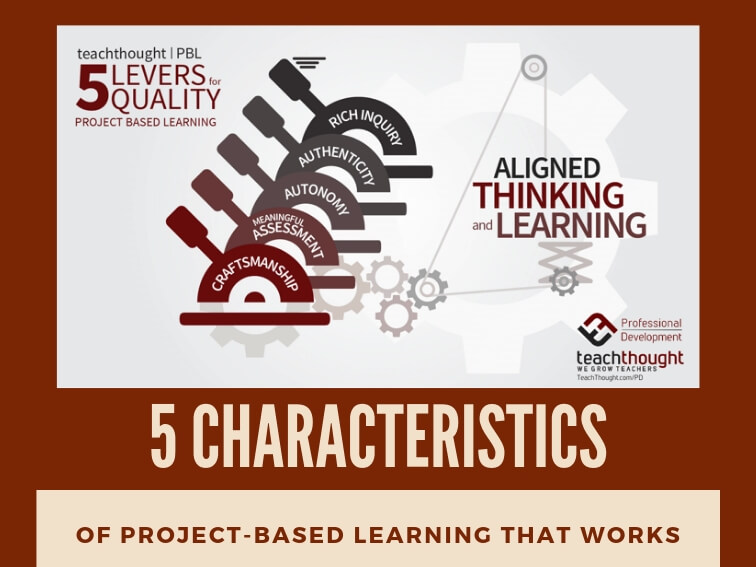
What Are The Characteristics Of Project-Based Learning That Works?
contributed by Drew Perkins
As I’ve written before, project-based learning can be an amazing tool for student, teacher, and school growth but only if you’re getting great thinking and learning as a result. It’s not enough to just have students making something or doing hands-on, experiential work.
Quality PBL takes advantage of built-in and designed levers of quality that helps the teacher as facilitator align the thinking and learning we’re after in our students. As the graphic above shows, it’s these 5 Levers of Quality working in concert that elevate the desired thinking and learning whether that be content standards, skills, or both.
Aligned Thinking and Learning
The project is intentionally designed to solicit thinking around desired standards, content, & skills students need to know.
When planning for project design what thinking and learning do we want our teaching to align with? While this certainly can be and most often is focused on content and standards, that may not necessarily be the case with all projects. In fact there’s a great case to be made for a very healthy balance between content and skills and perhaps even focusing on thought to more deeply learn content. The big emphasis here though is that there is intentionality in planning on the part of the teacher/facilitator about the thinking and learning, whatever that may be, that students will need to know and demonstrate understanding of in order to complete the project and challenge.
Rich Inquiry
The project provides multiple opportunities & need for high-level questioning by students & teacher.
Good facilitators/teachers plan good questions to ask learners, great ones plan for scenarios from which great questions grow from everyone. Throughout a project, we want to see opportunities and the need for students and teachers to ask questions both planned and organically. Starting with an open-ended Driving Question aligned with the desired thinking and learning, students might have questions for an outside expert, questions for fellow students around a text or other resources, questions to help lead the thinking of others, or just clarifying questions. Moving from a classroom where answers are the norm, rich inquiry yields profound thinking and creativity as one idea builds upon another.
Authenticity
The project challenges students to create products for real-world purposes & audiences.
Students (and teachers) need to be clear about the product, purpose, and audience in a project and this is closely linked to authenticity. Connecting the product to an authentic purpose and audience allows another leverage point that is missing if the work is just “for school”. Instead of asking how many points they earned or what their grade is, authenticity shifts those inquiries to asking if and how well the work is serving the purpose and needs of the audience. While we do want to use the process and the products of PBL to measure learning, the addition of authenticity helps to increase student interest and engagement and can empower them as they do real, meaningful, and purposeful work that transcends traditional schoolwork.
Listen to the Podcast HERE.
Autonomy
The project provides opportunities for student voice & choice in the process & product.
As Daniel Pink notes so eloquently notes in Drive: The Surprising Truth About What Motivates Us, if you want commitment and engagement, not just compliance, self-direction is better. As teachers and students grow in a PBL environment this is a culture shift where teachers are increasingly releasing “control” and becoming more of a facilitator. This autonomy can show up in a number of ways including allowing for increased student inquiry and choice over what to investigate, how to uncover the necessary learning as well as the ways in which they will show they know and understand.
Meaningful Assessment
The project guides teaching & learning using purposeful formative and summative assessments.
Ask most students how they feel about assessment and you’re likely to get a less than positive response but this doesn’t have to be the case. Using assessment as a tool to inform next steps and needed areas of improvement can be exciting, especially when the work is authentic, meaningful and purposeful. Meaningful assessment can come in many forms including formal and informal and may in fact be questions, not always just answers. It can also originate from multiple sources including self, peers, outside experts, and of course teachers.
Craftsmanship
The project provides opportunities & reasons for students to create craftsman-like products.
We want students to produce high-quality work and thinking but how often do we provide them with authentic challenges that they see as worthy of refinement and improvement outside of pursuit of just a grade? Quality project-based learning empowers students by engaging them in processes of reflection and revision as they seek to improve their products to meet the needs of an authentic audience instead of just playing school.
Interested in learning more about how to leverage great thinking and learning using authentic project-based learning?